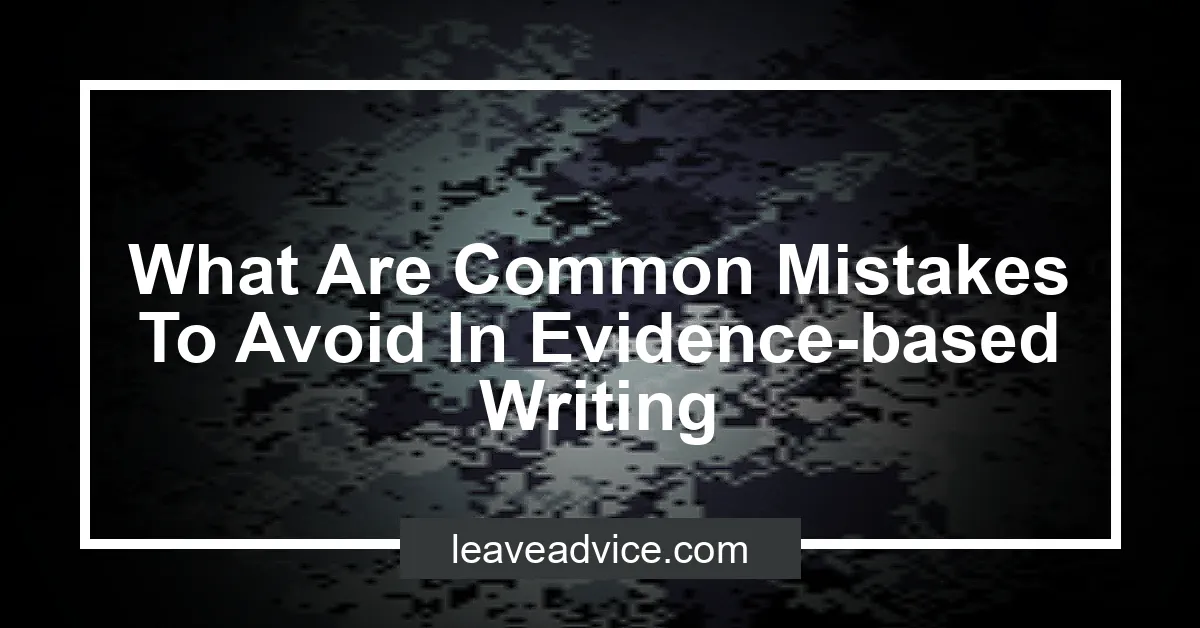What Are Common Mistakes To Avoid In Evidence-based Writing


Evidence-based writing involves using outside sources to support your own ideas, giving your writing credibility and strength in argument. Avoiding common mistakes in evidence-based writing is important in ensuring the accuracy and effectiveness of your writing.
Common mistakes to avoid in evidence-based writing include poor organization, overly complex language, weak arguments, inadequate research, and lack of proofreading.
Check out this Youtube video on “Mistakes to Avoid in the Introduction Section | Research Paper” to learn what common mistakes to avoid in evidence-based writing are related to the introduction section of a research paper.
Lack of Clear Research Question
The importance of a clear research question lies in its ability to chart the course for the entire study. It acts as a guiding star, steering the research toward specific objectives, study designs, and data collection methods.
A well-defined question sharpens the focus and purpose of the research, leading to more effective outcomes and enabling targeted decision-making throughout the study.
Examples of unclear research questions
An unclear research question can derail the entire study. For instance, a question like “How does music affect people?” lacks specificity and measurability, making it challenging to design an effective study.
Similarly, “What are the impacts of technology on society?” lacks the necessary precision and could yield ambiguous or inconclusive results.
Tips for formulating a clear research question
To ensure the clarity of a research question, it’s essential to make it specific, measurable, achievable, relevant, and time-bound (SMART). Additionally, conducting a thorough review of existing literature, identifying gaps, and aligning the question with the research objectives can significantly enhance its clarity.
| Research Questions | Clarity Evaluation |
|---|---|
| How can education impact career success? | Unclear – lacks specificity and measurability |
| What do people think about environmental policies? | Unclear – lacks precision and measurability |
| What are the effects of climate change on agricultural practices in developing countries? | Clear – specific, measurable, and relevant |
| How can social media influence consumer behavior? | Unclear – may lack specificity and measurability |
Remember, a clear research question is the cornerstone of a successful study, guiding every step from inception to conclusion.
Failure to Use Reliable Sources
Using unreliable sources in evidence-based writing can have a detrimental impact on the overall credibility and reliability of the content. It can lead to misleading information, weak arguments, and a lack of trust from the audience.
This can ultimately undermine the effectiveness of the writing and diminish its impact on the readers.
How to identify reliable sources
Identifying reliable sources is crucial for maintaining the integrity of evidence-based writing. One way to do this is by evaluating the depth, objectivity, currency, authority, and purpose of the source.
Look for well-researched, peer-reviewed articles, and information from reputable organizations or experts in the field. Cross-referencing multiple sources can also help in validating the reliability of the information.
Examples of unreliable sources
There are several examples of unreliable sources, including social media platforms such as Facebook and Twitter, which often propagate misinformation. Additionally, Wikipedia, YouTube, and essay-sharing websites are notorious for housing unverified and untrustworthy content.
It’s important to steer clear of these sources when conducting evidence-based writing to ensure the accuracy and authenticity of the information presented.
Misinterpretation of Data
The consequences of misinterpreting data
Misinterpreting data can lead to making critical business decisions based on flawed information, resulting in financial losses and a damaged reputation. Whether it’s overlooking outliers or misjudging correlation as causation, the consequences can be dire.
Tips for accurately interpreting data
Accurately interpreting data necessitates a keen eye for detail and a sound understanding of statistical analysis. It’s crucial to verify data sources, ensure statistical significance, and avoid confirmation bias.
Also, using reliable visualization tools can aid in grasping the true insights hidden within the data.
Real-life examples of data misinterpretation
An infamous example of data misinterpretation is the case of misleading statistics in toothpaste advertising where dentists were asked to list recommended brands, leading to misleading conclusions. Similarly, the usage of inappropriate chart types and inconsistent scales in data visualization can obscure the true story behind the numbers, leading to misinterpretations and misinformed decisions.
Overreliance on Personal Opinion
The dangers of relying too much on personal opinion in evidence-based writing
Relying excessively on personal opinion in evidence-based writing can undermine the credibility of the content. It can lead to bias, inaccuracy, and subjectivity, diminishing the strength of the evidence presented.
Moreover, it may alienate the audience who expects factual information based on research and data rather than subjective viewpoints.
Strategies for balancing personal opinion with evidence
To strike a balance, one can employ the practice of robustly citing reputable sources and studies. Integrating personal experiences can be beneficial, but it’s crucial to supplement them with concrete evidence.
Additionally, seeking feedback from peers and experts can help in evaluating the alignment of personal opinions with established evidence.
Anecdotes about the impact of personal opinion on writing
In my professional experience, I encountered a situation where a colleague’s overreliance on personal opinion led to a misunderstanding among the audience. By incorporating only anecdotal evidence, the content lacked depth and failed to resonate with the readers who sought well-supported arguments.
This instance emphasized the necessity of amalgamating personal insights with concrete evidence to enhance the persuasiveness and trustworthiness of the written material.
| Personal Opinion | Balancing Strategies | Impact of Overreliance |
|---|---|---|
| Can lead to bias and subjectivity | Cite reputable sources | Content lacks depth and trustability |
| Undermines credibility | Seek feedback | Misunderstandings among the audience |
Neglecting Counterarguments
The significance of addressing counterarguments in evidence-based writing
Neglecting to address counterarguments in evidence-based writing diminishes the credibility and persuasiveness of the argument. Failing to acknowledge and refute opposing viewpoints suggests a lack of thorough research and understanding, weakening the overall case presented.
Techniques for incorporating counterarguments effectively
To effectively incorporate counterarguments in evidence-based writing, one should anticipate potential objections and analyze them objectively. Refute the counterarguments logically using credible sources and evidence, shunning ad hominem attacks.
Addressing counterarguments demonstrates a comprehensive understanding and respect for diverse perspectives.
Examples of the negative consequences of neglecting counterarguments
Neglecting counterarguments can lead to weakened arguments and reduced persuasiveness. For instance, in a legal essay, failing to address counterarguments could diminish the overall strength of the argument and the author’s credibility.
Additionally, neglecting counterarguments can result in biased and one-sided arguments, undermining the author’s ability to effectively persuade the audience.
Failure to Cite Sources Properly
Failing to cite sources or using them improperly can lead to accusations of academic dishonesty or plagiarism. This misconduct can have serious consequences, including failing a course or even expulsion from an academic program.
Proper citation is imperative to uphold academic integrity and give credit to the original authors of the information being used.
Confusing Correlation with Causation
Correlation refers to a relationship between two variables where a change in one variable is associated with a change in the other, but it does not imply causation. Causation, on the other hand, suggests that one event is the direct result of the occurrence of another event.
In simpler terms, correlation does not prove causation.
The difference between correlation and causation
Correlation is simply a statistical association between variables, indicating that changes in one variable are related to changes in another. Causation, however, implies a direct cause-and-effect relationship, where one variable directly influences the other to change.
Examples of mistaking correlation for causation
An example of mistaking correlation for causation is assuming that an increase in ice cream sales causes a rise in shark attacks, simply because both events occur more frequently during hot weather. Similarly, the correlation between vaccination rates and autism does not prove that one causes the other, as other factors may be at play.
Strategies for avoiding this common mistake
To avoid mistaking correlation for causation, it is crucial to conduct thorough research and consider alternative explanations for observed correlations. Employing controlled experiments and establishing temporal precedence can help differentiate between correlation and causation.
Additionally, seeking expert guidance and critically analyzing data can prevent fallacious assumptions about causation based solely on correlation.
Using Outdated Information
Using outdated information in evidence-based writing can have detrimental effects on the credibility and accuracy of the content. Outdated information may lead to misconceptions, misinterpretations, and Misinformation, which can significantly impact the decision-making process and overall understanding of a topic.
The negative effects of using outdated information in evidence-based writing
The negative effects of using outdated information in evidence-based writing are far-reaching. It can undermine the validity of the entire argument or study, leading to erroneous conclusions or recommendations.
Additionally, it can diminish the author’s credibility and erode the trust of the audience or readers.
Tips for ensuring information is current and relevant
To ensure that information is current and relevant, it is essential to cross-check the data with multiple sources and verify the accuracy of the information. Moreover, authors should prioritize using up-to-date literature, studies, and research findings to maintain the currency and credibility of their work.
Embracing a systematic approach to reviewing and verifying information is pivotal in avoiding the pitfalls of outdated data.
Historical examples of outdated information leading to misinformation
Historically, numerous instances have demonstrated the perils of relying on outdated information. From misguided medical practices based on obsolete research to flawed policy decisions stemming from inaccurate historical data, the repercussions of using obsolete information in shaping beliefs and actions have been profound.
Learning from these historical examples reinforces the importance of prioritizing current and reliable sources in evidence-based writing.
Neglecting the Peer Review Process
The value of peer review in evidence-based writing
Neglecting the peer review process deprives writers of valuable feedback and insights from peers, hindering the refinement and enhancement of the quality, accuracy, and credibility of their evidence-based writing.
Steps for seeking and implementing peer review
To seek and implement effective peer review, writers should actively engage in networking with colleagues and industry professionals, openly requesting constructive criticism, and reciprocally contributing to the peer review process. They should also prioritize an environment of trust and mutual respect, encouraging honest and insightful feedback.
Success stories of peer review improving writing quality
Many writers have experienced significant improvements in their writing quality through peer review, such as refining research methodologies, strengthening logical arguments, and enhancing the overall clarity and persuasiveness of their evidence-based content.
Lack of Clarity and Conciseness
The impact of unclear and verbose writing on evidence-based arguments can be quite detrimental. When the writing lacks clarity and conciseness, it becomes challenging for readers to grasp the core arguments and evidence presented.
This leads to confusion and may result in misinterpretation or dismissal of the evidence provided.
Techniques for achieving clarity and conciseness in writing involve embracing brevity, eliminating unnecessary phrases, and using clear and straightforward language. Writers should also opt for the active voice and avoid relying too heavily on a thesaurus for complex words.
It’s crucial to know the audience and use technical terms sparingly to ensure the message is conveyed effectively.
Examples of how clear and concise writing strengthens evidence-based arguments can be seen in academic essays that present solid, well-structured arguments supported by credible evidence. By incorporating concrete, specific examples and cutting out extra words and weak qualifiers, writers can effectively strengthen their evidence-based arguments through clear and concise writing.
| Techniques for Achieving Clarity and Conciseness |
|---|
| Embrace brevity |
| Eliminate unnecessary phrases and redundancies |
| Use clear and straightforward language |
| Write in active voice |
| Shorten wordy phrases |
Failing to Consider Audience Needs
The importance of tailoring evidence-based writing to the audience is paramount. Failure to do so can result in a lack of engagement and comprehension among the readers.
When evidence-based writing is not tailored to the audience, the key message may get lost, leading to misinterpretation and reduced impact.
Strategies for considering audience needs
Implementing audience-centered strategies is essential. This involves understanding the demographics, preferences, and knowledge level of the target audience.
By conducting thorough research and developing audience personas, writers can tailor their evidence-based content to resonate with the specific needs and interests of the readers. Creating relatable and understandable content is crucial in ensuring that evidence-based writing effectively communicates its intended message.
Case studies of successful audience-focused writing
An exemplary case of successful audience-focused writing can be seen in the health industry, where complex medical research is presented in a more digestible format for patients and their families. By simplifying the language and emphasizing the practical implications of the research, these materials effectively cater to the audience’s needs.
Additionally, in the field of marketing, companies have excelled in tailoring evidence-based content to cater to different target consumer segments, resulting in increased engagement and conversion rates.
Ignoring Ethical Considerations
The ethical implications of evidence-based writing are crucial to maintain integrity and credibility in the field of research. By disregarding ethical considerations, writers risk undermining the trustworthiness of their work and misleading their audience.
Ethical implications encompass aspects such as plagiarism, bias, and the use of exclusive language, which can significantly impact the validity and persuasiveness of the writer’s arguments.
Ensuring ethical writing practices is essential for upholding the principles of integrity and honesty in evidence-based writing. This involves actively avoiding unethical behaviors such as plagiarism, data fabrication, and misrepresentation of sources.
Writers must uphold the highest standards of honesty, accuracy, and transparency in their work to maintain the ethical integrity of evidence-based writing.
Examples of unethical writing practices to avoid include plagiarism, research data falsification, duplicate publication, and authorship conflicts. These unethical behaviors can severely compromise the integrity of evidence-based writing and erode the trust of the audience and the academic community.
Upholding ethical standards is vital to ensuring the reliability and credibility of evidence-based writing.
| Unethical Writing Practices to Avoid | Examples |
|---|---|
| Plagiarism | Copying text without proper citation |
| Research Data Falsification | Manipulating or fabricating research findings |
| Duplicate Publication | Republishing previously published work without acknowledgment |
| Authorship Conflicts | Disputes regarding contributions and credits for a research publication |
Ensure to adhere to ethical writing practices to maintain the credibility of evidence-based work and uphold the integrity of the academic and research community.
Recommended Amazon Products for Evidence-Based Writing
Here’s a curated list of products that can help you improve your evidence-based writing skills:
The Sense of Style: The Thinking Person’s Guide to Writing in the 21st Century by Steven Pinker


This book is recommended for enhancing clarity and conciseness in writing. It offers actionable tips on achieving precision and engaging the audience effectively.
| Pros | Cons |
|---|---|
| Easy to understand language | May require extensive reading |
| Practical writing guidance | Limited focus on specific evidence-based writing mistakes |
| Insightful examples | N/A |
The Elements of Style by William Strunk Jr. and E. B. White


This classic book is essential for avoiding common writing pitfalls. It provides timeless advice on grammar, style, and effective communication.
| Pros | Cons |
|---|---|
| Clear and concise writing rules | Some advice may be considered outdated |
| Highly respected resource | General focus on writing principles |
| Useful for various writing genres | N/A |
The Chicago Manual of Style, 17th Edition


As a comprehensive style guide, this manual is crucial for proper citation and formatting in evidence-based writing. It offers detailed instructions for referencing sources, a key component of credible writing.
| Pros | Cons |
|---|---|
| Robust guidelines for citation | Complex for beginners |
| Widely used by academic and professional writers | Expensive for occasional use |
| In-depth explanations of citation styles | N/A |
Grammarly Premium


This tool assists in identifying and correcting grammar, punctuation, and style issues in writing. It ensures that evidence-based writing is error-free and polished.
| Pros | Cons |
|---|---|
| Enhances writing clarity | Premium version requires a subscription |
| Checks for plagiarism | May not catch all nuanced errors |
| Provides detailed writing suggestions | N/A |
The Writing Process Chart Poster


A visual aid like this poster can serve as a supportive tool for understanding the sequential stages of the writing process. It helps writers organize their evidence-based content effectively.
| Pros | Cons |
|---|---|
| Visual representation of writing steps | Limited to visual learning preferences |
| Helps in planning and revising | Not a direct writing aid |
| Suitable for all age groups | N/A |
Top Recommended Product for Evidence-Based Writing
If you’re looking for the best solution for improving your evidence-based writing, we highly recommend The Sense of Style: The Thinking Person’s Guide to Writing in the 21st Century by Steven Pinker. This book offers actionable tips on achieving precision and engaging the audience effectively. Ready to improve your writing skills? Check out The Sense of Style today for the best results!
Conclusion
It is crucial to avoid common mistakes in evidence-based writing to ensure the accuracy and credibility of the information presented. By steering clear of errors such as cherry-picking data, relying on outdated sources, and using biased language, writers can effectively convey their message and support their claims with reliable evidence.
Furthermore, readers are encouraged to apply the strategies and examples provided in this outline to improve their evidence-based writing. By recognizing and rectifying these common mistakes, writers can enhance the quality and persuasiveness of their arguments, leading to more impactful and convincing communication.
Lastly, the significance of evidence-based writing in various contexts cannot be overstated. Whether in academic, professional, or personal settings, the ability to present well-supported and accurate information is crucial for making informed decisions, building credibility, and influencing others.
Therefore, it is essential to prioritize precision and integrity in evidence-based writing to achieve the desired impact.




